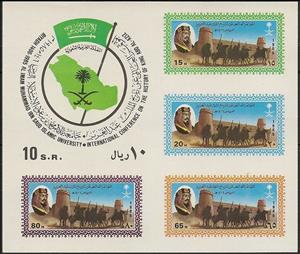Souvenir Sheet: Fort Masmak and Rider (Saudi Arabia 1985)
Fort Masmak and Rider (Saudi Arabia 1985)
01 December (Saudi Arabia ) within release King Abd al-Asis III. Ibn Saud (1880-1953) goes into circulation Souvenir Sheet Fort Masmak and Rider face value 10 Saudi riyal
| Souvenir Sheet Fort Masmak and Rider in catalogues | |
|---|---|
| Michel: | Mi: SA BL20 |
Souvenir Sheet is square format.
Also in the issue King Abd al-Asis III. Ibn Saud (1880-1953):
- Stamp - Fort Masmak and Rider face value 80;
- Stamp - Fort Masmak and Rider face value 20;
- Stamp - Fort Masmak and Rider face value 65;
- Stamp - Fort Masmak and Rider face value 15;
- Souvenir Sheet - Fort Masmak and Rider face value 10;
Souvenir Sheet Fort Masmak and Rider it reflects the thematic directions:
King is the title given to a male monarch in a variety of contexts. The female equivalent is queen regnant (while the title of queen on its own usually refers to the consort of a king). In the context of prehistory, antiquity and contemporary indigenous peoples, the title may refer to tribal kingship. Germanic kingship is cognate with Indo-European traditions of tribal rulership (c.f. Indic rājan, Gothic reiks, and Old Irish rí, etc.) In the context of classical antiquity, king may translate Latin rex or either Greek archon or basileus. In classical European feudalism, the title of king as the ruler of a kingdom is understood as the highest rank in the feudal order, potentially subject, at least nominally, only to an emperor (harking back to the client kings of the Roman Empire). In a modern context, the title may refer to the ruler of one of a number of modern monarchies (either absolute or constitutional). The title of king is used alongside other titles for monarchs, in the West prince, emperor, archduke, duke or grand duke, in the Middle East sultan or emir; etc. Kings, like other royalty, tend to wear purple because purple was an expensive color to wear in the past.
A map is a symbolic depiction emphasizing relationships between elements of some space, such as objects, regions, or themes. Many maps are static, fixed to paper or some other durable medium, while others are dynamic or interactive. Although most commonly used to depict geography, maps may represent any space, real or imagined, without regard to context or scale, such as in brain mapping, DNA mapping, or computer network topology mapping. The space being mapped may be two dimensional, such as the surface of the earth, three dimensional, such as the interior of the earth, or even more abstract spaces of any dimension, such as arise in modeling phenomena having many independent variables. Although the earliest maps known are of the heavens, geographic maps of territory have a very long tradition and exist from ancient times. The word "map" comes from the medieval Latin Mappa mundi, wherein mappa meant napkin or cloth and mundi the world. Thus, "map" became the shortened term referring to a two-dimensional representation of the surface of the world.


